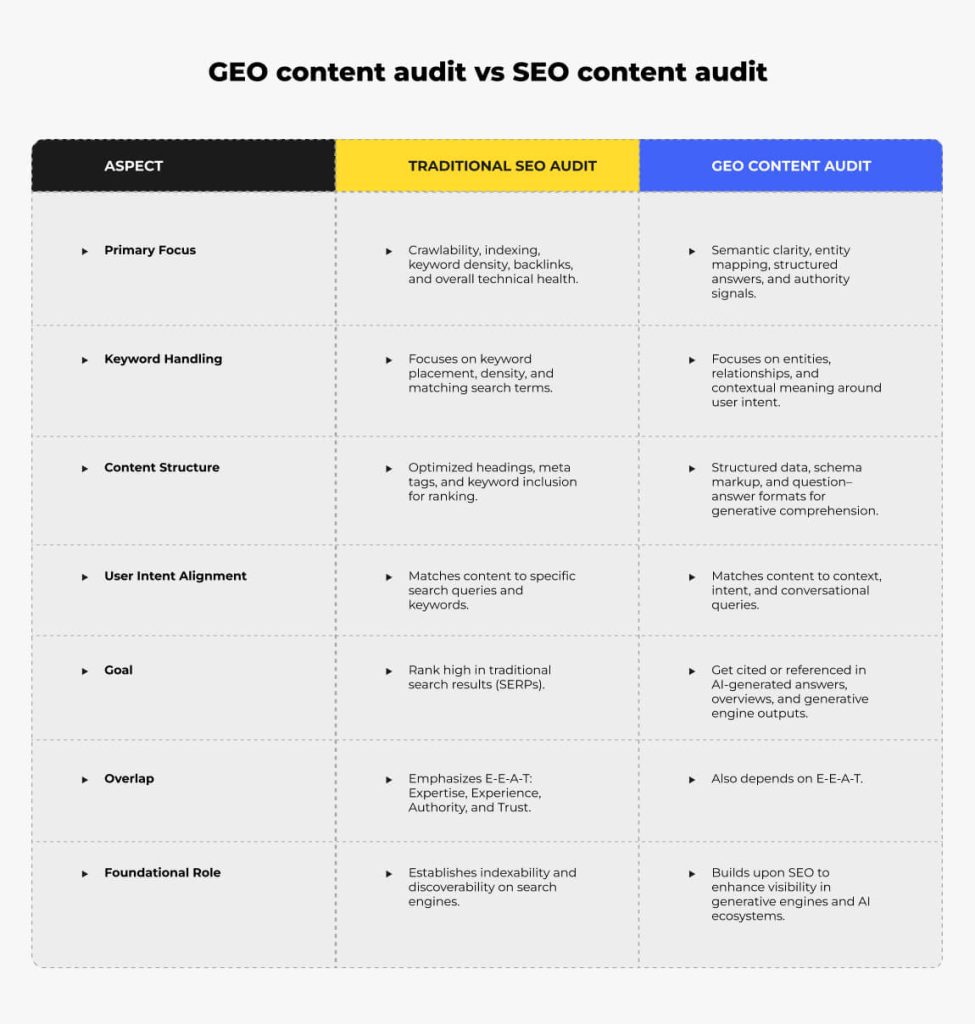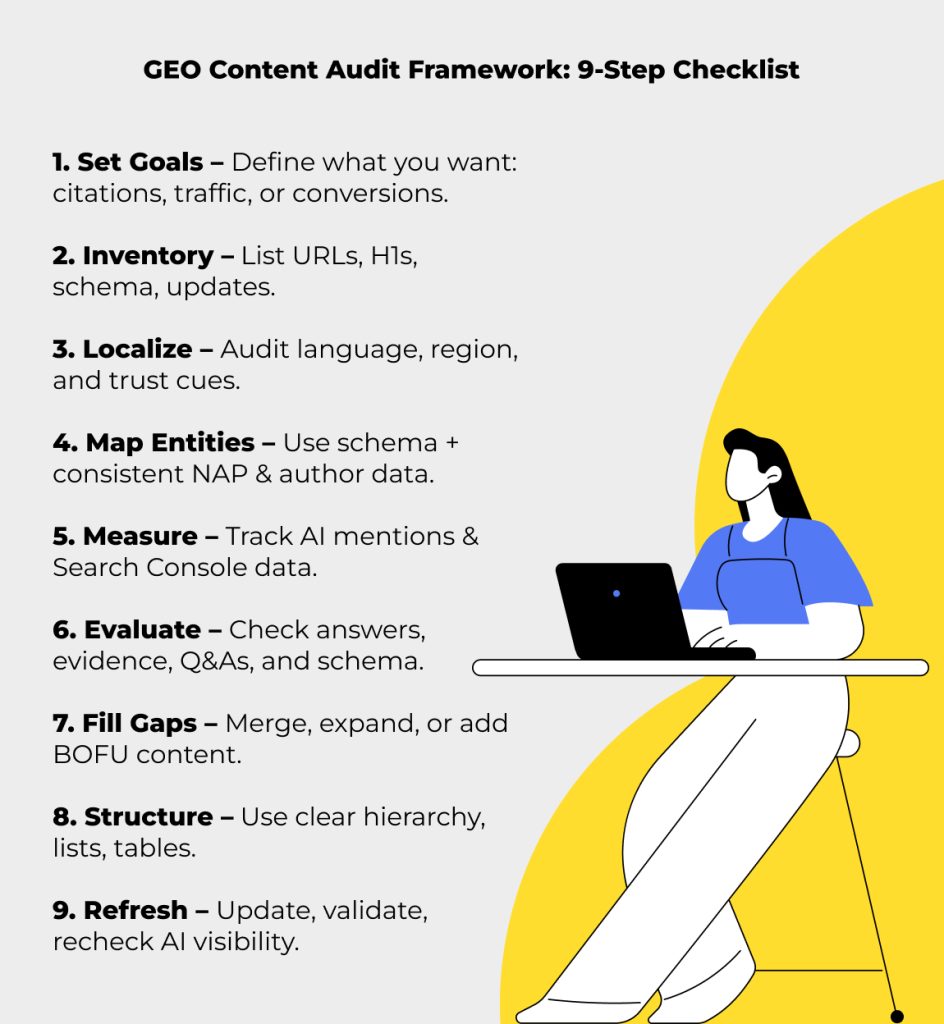Users now turn to generative engines to solve problems and make buying decisions.
ChatGPT alone handles over 125 million prompts a day. And the answers it returns are increasingly direct and actionable—not a list of links to plough through.
It is as if everything changed overnight. SEO, as we knew it, stopped being enough.
Generative AI platforms like ChatGPT, Perplexity, and Gemini now pull, summarize, and cite content in entirely new ways. LLMs don’t crawl the web like traditional search engines. They synthesize answers by learning from pre-ingested content.
To earn your spot in those answers, your content must be structured, factual, and easy to parse—for both users and machines. The reward? More visibility and higher chances of being name-dropped in AI responses.
Enter GEO.
Generative Engine Optimization. It’s what makes your content findable and usable inside AI-generated answers.
So, does that mean you need to rewrite your content for GEO? Probably. But before you do, run a GEO content audit to see how well your existing content performs in AI-driven search.
Enough theory. Let’s get practical—and break down how a GEO content audit actually works.
GEO-targeted content: The new currency of generative search
In the world of generative search, content is the currency LLMs spend when deciding which sources to cite. The clearer, more structured, and verifiable your content, the more likely it is to be selected, summarized, and reused.
Does that mean the classic SEO rules are bygone for today’s content?
Not at all. In our work with clients (and on our own site), we’ve seen that to attract and convert qualified traffic, you still need to have traditional SEO in place.
“Good SEO is good GEO”, as Google’s Danny Sullivan puts it.
However, to gain and maintain the position of a trustworthy resource in the AI searches, you need a new layer of analysis. That’s digging deep into how and why generative engines surface information.
This helps your content earn trust inside generative systems themselves and amplify your brand’s presence.
Here’s why a GEO-targeted content strategy can become the rhyme and reason to AI visibility–
Danny explains that the future of search is answers, not rankings. The emphasis shifts from ranking on SERPs to aligning content with search intent, thereby securing brand mentions in answers by generative engines.
Writing such credible, clear content serves two audiences:
- Humans, who need useful, understandable information.
- Machines (LLMs), which need to understand and trust the content before it cites that in response to intent-driven queries.
Meaning that strategic content organization and intentional semantic choices should never go out of sight. Because?
- Because LLMs don’t crawl like traditional search engines. They synthesize information from vast, pre-ingested datasets. Websites, forums, reviews, directories, and proprietary sources, everything.
- Each model has its own scope and update frequency. But visibility in generative systems depends on where and how your brand appears across the web ecosystem.
- Well-structured, factual content acts as a teaching node for LLMs. It demonstrates accuracy, authority, transparency, and consistency over time. And that’s the essence of E-E-A-T and credibility signals to generative engines.
- Besides, citation frequency, domain reputation, and content freshness are also rewarded as they indicate reliability for LLLMs.
In summary, the content that meets three criteria has good chances to become the source behind the answers AI-powered search engines provide:
- Structured formatting: Predictable headings, tables, lists, and labeled data is easier for LLMs to extract and reuse. Pillar pages and hub-and-spoke models better your chances at getting referenced.
- Factual reliability: Sources, data points, and transparent attribution reduce misrepresentation or hallucination.
- Semantic clarity: Consistent entity names, terminology, and context help models map meaning accurately.
As Wei Zheng, Chief Product Officer at Conductor, notes:

What is a GEO content audit? How does it differ from an SEO content audit?
A GEO content audit is a strategic review of how your content performs in the eyes of generative engines like ChatGPT, Gemini, and Perplexity. Not another round of keyword cleanups or broken-link fixes.
When we talk to brands, the same questions come up every time:
- “Our content ranks well on Google, but why doesn’t it show up in ChatGPT’s answers?”
- “Do we have to rewrite everything from scratch to make it GEO-ready?”
- “Google still drives most of our traffic, how do we justify optimizing for AI search too?”
Fair questions. And we’ve seen the same pattern across dozens of content-heavy clients: traditional SEO stays, but it’s not enough to come in generative search rankings.
That’s why the GEO content audit.
Just like SEO content audit, GEO auditing matters as it futureproofs your content for AI search visibility.
Plus, as LLMs evolve, the GEO-targeted content strategy goes stale. Auditing helps your GEO adapt to these changes without affecting your AI discoverability.
How different is a GEO content audit from an SEO content audit?

GEO content audit: Step-by-step framework
We’ve put together a GEO audit checklist for a handful of clients, and these plans always entail the following pillars:

1) Set goals
Decide what you want from auditing your GEO content. Common objectives include:
- Increasing how often your brand/content is cited in AI responses (ChatGPT, Perplexity, Gemini, Google AI Overviews).
- Lifting branded homepage sessions and inquiries from AI-assisted searchers.
- Correlating specific page topics to revenue by hooking up your audit data to your attribution tool.
To measure progress, add “ChatGPT/AI search” to your sales or contact forms.
Pro Tip: Add a “How did you hear about us?” field in forms that includes “AI/ChatGPT” to watch for how often leads are first heard about you from AI.
2) Build a content inventory
Your content inventory is the foundation of the audit:
- Export all URLs with title, H1, canonical, last updated, author, word count, internal links, and target query/theme.
- Add custom fields:
- Direct Answer Present: Is there a <120-word answer at the top?
- FAQ Present: Does it mirror prompt-style questions and include schema markup?
Tools: Screaming Frog, Sitebulb, ContentKing
3) Segment by market, language, and geography
AI visibility is highly sensitive to regional SEO content performance:
- Sort your content inventory by domain, subdomain, or folder (e.g., .co.uk, /fr/).
- Account for language differences (US vs. UK English, Spain vs. Mexico Spanish).
- For international content, review
- Language accuracy.
- Local cues: currency, units, certifications, trust badges
- Currency
- VAT
- Region-specific CTAs
- Location-specific phone numbers
Misaligned international content signals confusion to both users and AI.
4) Entity mapping and knowledge graph integration
Generative search engines use strong entity signals. It helps them link your brand with the relevant categories and locations. For local businesses:
- NAP consistency (Name, Address, Phone) across website, Google Business Profile, and directories
- Schema markup: LocalBusiness, Organization, Service
- Internal linking that reinforces entity relationships.
Check out the following post for expert guidance on local SEO:
- AI in local SEO: Your new secret weapon or just another shiny tool?
- 7 Must-Do Local SEO Steps to Rank Higher on Google Maps
- What is Mavlers’ approach to local SEO?
- The Ultimate Guide to Overcoming Local SEO Challenges and Owning Your Local Market
- Affordable SEO Tools That Actually Work: Our Tried-and-Tested Tech Stack
5) Pull performance metrics
- Organic sessions, conversions, and direct traffic trends.
- Google Search Console clicks, impressions, and query performance.
- Manual logs of AI citations: which prompts mention your brand and which competitors get cited.
6) Evaluate content substance
Go page by page and see if the GEO content meets the four criteria:
- Direct Answers: Short, clear summaries at the top of the page. Ask: Is the answer up front and clear?
- Evidence: Proprietary data, quotes, or external reference. Ask: Are claims supported with evidence?
- Question-Answer Sections: Cover primary queries, use cases, pricing, and variations. Ask: Does the FAQ section match natural prompt fragments?
- Schema: FAQ, HowTo, Product, Organization/Author with published/updated dates. Ask: Is schema markup present?
7) Identify gaps, duplicates, and opportunities
Look for weak links and remove them, and create a wholesome content ecosystem:
- Merge duplicates or cannibalizing pages. Know which page gives the best answer.
- Create missing BOFU content. Alternatives, comparisons, pricing, and implementation guides are valuable content to build.
- Are you listed on 3rd-party “Best of” lists, forums, or review sites where LLMs often “shop” for citations?
Backlink and review monitoring tools (Ahrefs, Google Alerts, G2, Capterra) are gold for this task.
8) Check content structure and semantic clarity
Even great content fails to please generative engines if poorly structured:
- Hierarchy: H1, H2, H3 to signal topical flow.
- Formatting: Tables, lists, summaries, short-answer blocks.
- Clarity: Avoid ambiguity, long sentences, and jargon.
- Semantic consistency: Ensure terms, synonyms, and concepts answer to user intent queries.
Get sorted with semantic analysis and keyword-to-intent alignment using tools like SurferSEO or Clearscope.
9) Question-answer coverage
Think like generative engines and prioritize content that mirrors the way people ask questions. Audit for:
- Primary and secondary queries for your brand.
- Question-answer formatting instead of continuous text blocks.
- FAQs addressing variations of high-value questions.
- Topic clustering for a complete coverage of the topic from multiple angles.
10) Citations & external validation
Gain a vote of confidence from external sources:
- Update outdated stats and references.
- Make links active and contextually described.
- Validate references with schema.org structured data.
- Track authoritative mentions online using brand monitoring tools.
- Remove or address negative mentions to maintain trustworthiness.
11) Experience & authority signals
Audit pages for E-E-A-T:
- Author bios and credentials.
- Backlinks from high-authority domains.
- Testimonials, case studies, and product reviews.
- Digital brand authority signals like podcasts, events, and press coverage.
12) Refresh and monitor
Keep an ongoing log of citations in AI results and organic metrics, retesting every week or month.
Focus on these steps, and you’ll be in much better shape to be referenced and regarded by generative systems of the world.
TL;DR: GEO content audit in a nutshell
- Why it matters: Makes your content discoverable, quotable, and trusted by AI search engines—not just rankable on Google.
- How it differs from SEO: Goes beyond keywords and backlinks—focuses on meaning, authority, and structured clarity.
- What it covers:
- Content structure: Pillar–cluster mapping for topic depth and hierarchy
- Semantics: Schema markup, Q&A formatting, and entity linking
- Credibility: Author validation, source signals, and brand authority
- Visibility: AI overview tracking and content retrievability
The road ahead
Want a quick gut check on how to unlock unclaimed revenue from your existing content articles—or a partner to help you with that? Let’s talk. With our AI-led audits, we’ll make sure AI can’t ignore you.
Until then, you’ve still got plenty of free insights from us:



Urja Patel - Content Writer
Urja Patel is a content writer at Mavlers who's been writing content professionally for five years. She's an Aquarius with an analyzer's brain and a dreamer's heart. She has this quirky reflex for fixing formatting mid-draft. When she's not crafting content, she's trying to read a book while her son narrates his own action movie beside her.
Low code & no code web development: What’s the real difference and why does it matter?
Link building tools in 2025: The real costs, trade-offs & what you should actually use